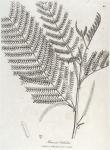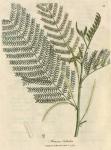
 Also see 067. Mimosa nilotica. Egyptian mimosa, Acacia, Egyptian thorn.
Also see 067. Mimosa nilotica. Egyptian mimosa, Acacia, Egyptian thorn.
Ex hujus plantse ligno paratur Catechu, vulgo Terra Japonica. Pharm. Lond. & Edinb.
Synonyma. Mimosa Cate; spinis duabus stipularibus, foliis bipinnatis 15-30 jugis, foliolis 40 jugis, spicis elongatis axillaribus. Vide Murray App. Med. vol. ii. p. 415.
Coira vel Caira in Provincia Bahar dicitur. See Kerr's "Description of the Plant from which the Terra Japonica is extracted." Med. Obs. & Inquir. vol. v. p. 151. Suppl. Plant. p. 439.
Class Polygamia. Ord. Monoecia. Lin. Gen. Plant. 1158.
Ess. Gen. Ch. Hermaph. Cal. 5-dentatus. Cor 5-fida. Stam. 5 s. plura. Pist. 1 Legumen.
Spec. Char. M. spinis stipularibus, foliis bipinnatis multijugis: glandulis partialium singulis, spicis axillaribus geminis s. ternis pedunculatis. Syst. Veg. ed. 14.
According to Mr. Kerr, this small tree grows to twelve feet in height, and to one foot in diameter; it is covered with a thick rough brown bark, and towards the top divides into many close branches: the leaves are bipinnated, or doubly winged, and are placed alternately upon the younger branches: the partial pinnae are nearly two inches long, and are commonly from fifteen to thirty pair, having small glands inserted between the pinnae: each wing is usually furnished with about forty pair of pinnulae or linear lobes, beset with short hairs: the spines are short, recurved, and placed in pairs at the bases of each leaf: the flowers are hermaphrodite and male, and stand in close spikes, which arise from the axillae of the leaves, and are four or five inches long: the calyx is tubular, hairy, and divides at the limb into five oval pointed segments: the corolla is monopetalous, whitish, and of the same form as the calyx, but twice its length: the filaments are numerous, capillary, double the length of the corolla, adhering at the base of the germen, and crowned with roundish antherae: the germen is oval, and supports a slender style, which is of the length of the filaments, and terminated by a simple stigma: the fruit, or pod, is lance-shaped, brown, smooth, compressed, with an undulated thin margin; it contains six or eight roundish flattened seeds, which produce a nauseous odour when chewed. This tree grows plentifully on the mountainous parts of Indostan, where it flowers in June.
An Indian drug, known by the name of Terra Japonica, and now more properly called Catechu, has long been an officinal medicine in Europe; and though soon discovered by chemical analysis to be of vegetable origin, yet neither was the plant from which it is produced, nor the process by which it is prepared, sufficiently ascertained for near a century afterwards. Writers on the Materia Medica very generally, from the time of Clusius, considered the Catechu to be extracted from the seeds of a nut, the produce of a species of palm; (Areca, or Beetle-nut) and conformably to this opinion, Linnaeus, in both the editions of his Mat. Med. refers this drug to the "Areca Catechu frondibus pinnatis, foliolis replicatis oppositis praemorsis." We are told however by Mr. Kerr, that in the Province of Bahar, where the Terra Japonica is manufactured, the price of the Areca-nut far exceeds that of the Catechu. [Mr. Kerr says, if the Terra Japonica were extracted from this nut, it would be twenty times dearer than in the present sales. Vide l. c.] But he thinks it probable that where this nut is in great plenty, "they may perhaps join some of the fruit in making the extract, to answer a double purpose, for the most frequent use of both is in chewing them together, as Europeans do tobacco; to these two substances they add a little shell lime, and a leaf called Pauw." [Hence the following lines: Quis foliis credat commixta cake tenellis, / Cum fructu hoc Indos vesci, unde ore cruento / Purpureum ejiciunt succum, tarn dentibus atris / Horrendum arringunt, & dentibus ore minantur?] Cleyerus and Herbert de Jager, [Vide Misc. Nat. Cur. Dec. 2. Ann. 4. Obs. 3. & Dec. 2, Ann. 3. p. 8.] more especially the latter, have asserted, that the Catechu is not extracted from one tree only, but from almost all the species of Acacia, whose bark is astringent and reddish, and from many other plants, which by boiling yield a juice of the like sort; and though these extracts differ consideraably, yet in India they are all denominated Khaath or Catechu. [The derivation of the word Catechu seems to favour this opinion; Cate, in the oriental language, signifies a tree, and Chu, juice.] But the tree which affords the best extract, according to his description, appears evidently to be a Mimosa. [According to the Linnaean nomenclature we have no genus under the name Acacia. But the Mimosas are very numerous, and that most known in Europe is the M. pudica, or humble sensitive plant, and the remarkable contractions which it manifests upon being touched, or even approached, induced my ingenious friend Dr. Marshal, to dissect the moving fibres. In his letter to me, he says, "I have made two or three dissections (more to gratify the curiosity of the moment than to ascertain any discovery) of the fleshy joints of the Mimosa pudica; branch is articulated with stem, petiolus with branch, and petiolus of the leafit with the common petiolus. Within the fleshy substance of the joint are found numerous white threads, which go from the one articulated body to the other, inserted into both. These it would appear, are the irritable fibres, by which the motions are performed."]
In this uncertainty our knowledge concerning the production of Terra Japonica still remained, till Mr. Kerr (assistant surgeon to the civil hospital at Bengal) transmitted an account of this substance, which completely removed every doubt reflecting its origin. In this account we are told, that he not only carefully attended to the process of the manufacturer in the preparation of Catechu, but that he actually repeated it himself; and upon the faith of the figure and description of the plant which he has given, and from which he prepared the Catechu, the younger Linnaeus has admitted it into the Supp. Plant. under the name of Mimosa Catechu; and we have accordingly figured the plant. The preparation of the extract is stated by Mr. Kerr to be as follows: "After felling the trees, the manufacturer carefully cuts off all the exterior white part of the wood. The interior coloured wood is cut into chips, with which he fills a narrow-mouthed unglazed earthen pot, pouring water upon them until he sees it among the upper chips; when this is half evaporated by boiling, the decoction, without straining, is poured into a flat earthen pot, and boiled to one third part; this is set in a cool place for one day, and afterwards evaporated by the heat of the sun, stirring it several times in the day; when it is reduced to a considerable thickness, it is spread upon a mat or cloth, which has previously been covered with the ashes of cow dung; this mass is divided into square or quadrangular pieces by a string, and completely dried by turning them frequently in the sun, until they are fit for sale." [In making the extract, the pale brown wood is preferred, as it produces the fine whitish extract: the darker the wood is, the blacker the extract, and of less value. They are very careful in drying their pots upon the fire, before they are used; but very negligent in cutting their chips upon the ground, and not straining the decoction, by which, and the dirty ashes they use, there must be a considerable quantity of earth in the extract, besides what avarice may prompt them to put into it." Kerr l. c.]
This extract is called Cutt by the natives, by the English Cutch, and by different authors Terra Japonica, Catechu, Khaath, Cate, Cachou, &c. "In its purest state it is a dry pulverable substance, outwardly of a reddish colour, internally of a shining dark brown, tinged with a reddish hue; in the mouth it discovers considerable astringency, succeeded by a sweetish mucilaginous taste. According to Lewis, "it dissolves almost totally in water, excepting the impurities; which are usually of the sandy kind, and amounting in the specimens I examined to about one-eighth of the mass. Of the pure matter, rectified spirit dissolves about seven-eighths into a deep red liquor: the part which it leaves undissolved, is an almost insipid mucilaginous substance." [Lewis's M. M. p. 642.] "Catechu may be usefully employed for most purposes where an astringent is indicated, provided the most powerful be not required. But it is particularly useful in alvine fluxes; and where these require the use of astringents, we are acquainted with no one equally beneficial. Besides this, it is employed also in uterine profluvia, in laxity and debility of the viscera in general, in catarrhal affections, and various other diseases where astringents are necessary. It is often suffered to dissolve leisurely in the mouth, as a topical astringent for laxities and exulcerations of the gums, for apthous ulcers in the mouth, and similar affections." [See Duncan's Edinb. New Dispens. p. 167.] "This extract is the basis of several fixed formulas in our pharmacopoeias, particularly of a tincture and an electuary: but one of the best forms under which it can be exhibited, is that of a simple infusion in warm water, with a proportion of cinnamon or cassia; for by this means it is at once freed from its impurities, and improved by the addition of the aromatic."
The antiseptic quality of Catechu appears from the experiments made by Sir John Pringle. (Vide Dis. of the Army, App. Exp. 10.) Huxham employed it successfully in cases where a putrid dissolved state of the blood prevailed. This extract is the principal ingredient in an ointment of great repute in India, composed of Catechu four ounces, alum nine drams, white resin four ounces; these are reduced to a fine powder, and mixed with the hand, adding olive oil ten ounces, and a sufficient quantity of water, to bring the mass to the consistence of an ointment. To all sores and ulcers in warm climates astringent applications of this kind are found to be peculiarly useful. See Kerr l. c.

